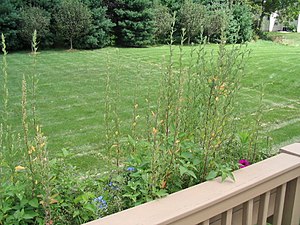
Image via Wikipedia
ScienceDaily (Jan. 22, 2010) — Dispelling the notion that urban "green" spaces help counteract greenhouse gas emissions, new research has found -- in Southern California at least -- that total emissions would be lower if lawns did not exist.
Turfgrass lawns help remove carbon dioxide from the atmosphere through photosynthesis and store it as organic carbon in soil, making them important "carbon sinks." However, greenhouse gas emissions from fertilizer production, mowing, leaf blowing and other lawn management practices are four times greater than the amount of carbon stored by ornamental grass in parks, a UC Irvine study shows. These emissions include nitrous oxide released from soil after fertilization. Nitrous oxide is a greenhouse gas that's 300 times more powerful than carbon dioxide, the Earth's most problematic climate warmer.
"Lawns look great -- they're nice and green and healthy, and they're photosynthesizing a lot of organic carbon. But the carbon-storing benefits of lawns are counteracted by fuel consumption," said Amy Townsend-Small, Earth system science postdoctoral researcher and lead author of the study, forthcoming in the journal Geophysical Research Letters. The research results are important to greenhouse gas legislation being negotiated. "We need this kind of carbon accounting to help reduce global warming," Townsend-Small said. "The current trend is to count the carbon sinks and forget about the greenhouse gas emissions, but it clearly isn't enough."
Turfgrass is increasingly widespread in urban areas and covers 1.9 percent of land in the continental U.S., making it the most common irrigated crop.
In the study, Townsend-Small and colleague Claudia Czimczik analyzed grass in four parks near Irvine, Calif. Each park contained two types of turf: ornamental lawns (picnic areas) that are largely undisturbed, and athletic fields (soccer and baseball) that are trampled and replanted and aerated frequently.
The researchers evaluated soil samples over time to ascertain carbon storage, or sequestration, and they determined nitrous oxide emissions by sampling air above the turf. Then they calculated carbon dioxide emissions resulting from fuel consumption, irrigation and fertilizer production using information about lawn upkeep from park officials and contractors.
The study showed that nitrous oxide emissions from lawns were comparable to those found in agricultural farms, which are among the largest emitters of nitrous oxide globally.
In ornamental lawns, nitrous oxide emissions from fertilization offset just 10 percent to 30 percent of carbon sequestration. But fossil fuel consumption for management, the researchers calculated, released about four times more carbon dioxide than the plots could take up. Athletic fields fared even worse, because -- due to soil disruption by tilling and resodding -- they didn't trap nearly as much carbon as ornamental grass but required the same emissions-producing care.
"It's impossible for these lawns to be net greenhouse gas sinks because too much fuel is used to maintain them," Townsend-Small concluded.
Previous studies have documented lawns storing carbon, but this research was the first to compare carbon sequestration to nitrous oxide and carbon dioxide emissions from lawn grooming practices.
The UCI study was supported by the Kearney Foundation of Soil Science and the U.S. Department of Agriculture.

![Reblog this post [with Zemanta]](http://img.zemanta.com/reblog_e.png?x-id=a9fe70af-35bc-499b-ab25-754054d888e2)
Comments